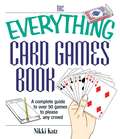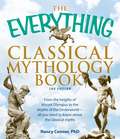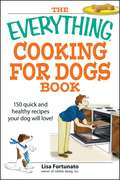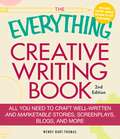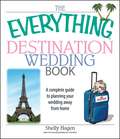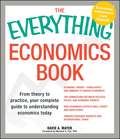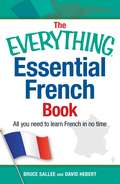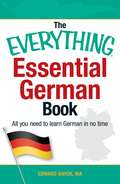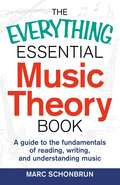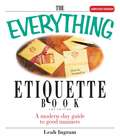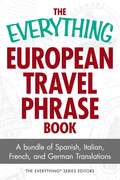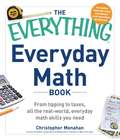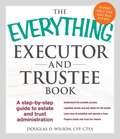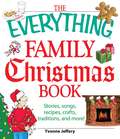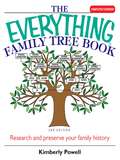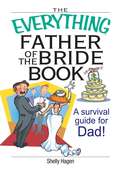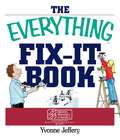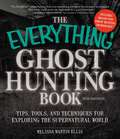- Table View
- List View
The Everything Card Games Book: A complete guide to over 50 games to please any crowd (Everything® Series)
by Nikki KatzIf you find yourself coming down with a case of rainy-day boredom or "I can't watch another rerun on TV" syndrome, grab the closest deck of cards and get ready for some serious fun! The Everything Card Games Book is packed with loads of variety to keep you entertained for hours with games you can play solo or with a group of people. Wow your friends and family with your card-shark skills by mastering these basic games - along with a handful of more advanced ones, too! In addition to key rules and instructions for play, The Everything Card Games Book provides tips on shuffling and dealing, essential etiquette, and knowing when to hold and when to fold.Learn how to play:Classic games, such as bridge and whistTeam games, such as pinochle and spadesVariations of games, such as Mexican Stud and Pai Gow PokerGames from abroad, such as Black Maria and Scopone ScientificoKids' games, such as Go Fish and Memoryand more!The perfect way to get you up to speed on more than fifty popular games, The Everything Card Games Book is your wild card for scoring big. Pull up a seat, gather your friends, and let the games begin!
The Everything Classical Mythology Book: From the heights of Mount Olympus to the depths of the Underworld - all you need to know about the classical myths (Everything® Series)
by Nancy ConnerRomance, betrayal, passion, tragedy, violence, and scandal. No, it's not the latest reality TV search for love--it's classical mythology.For years, people have turned to the ancient Greek and Roman myths for entertaining reading, unbelievable storylines, unique characters, and unparalleled drama. This guide explains the great stories and how they still influence literature, entertainment, and everyday life. From heroes and heroines to monsters and villains, this entertaining guide covers it all. Inside, you will learn how:The Greeks defeated the TitansOdysseus tricked the CyclopsHercules accomplished the twelve laborsPeruses slew MedusaThe Greeks bested the TrojansHades abducted PersephoneBellerophon killed the Chimera With an easy reference chart of the gods and goddesses and their interrelations, this action-packed book helps you bring classical mythology to life!
The Everything Cooking for Dogs Book
by Lisa FortunatoThe Everything Cooking for Dogs Book is packed with 100 delicious recipes and useful information on caring for a pooch's nutritional needs. Readers will delight to find 150 easy-to-prepare healthy treat and meal alternatives their pooch will love. From birthday parties to everyday rewards, this book provides a recipe for every occasion. Readers will also learn to care for their furry family member's nutritional health. Co-authored by a dog nutrition specialist and canine baker, this book will give readers all they need for fabulous home-made birthday cakes, treats and kibble.Featuring such fur-licious recipes as:Savory Bacon, Cheddar & Oatmeal BiscuitsGreen Apple Pie & Cheddar BiscottiMini Turkey Sausage BurgersPigs 'n BlanketBanana Carob Chip CakeAnd the Best Carrot Cake Ever!The Everything Cooking for Dogs Book has everything human companions need for a happy and healthy dog!
The Everything Cooking for Dogs Book: 100 quick and easy healthy recipes your dog will bark for!
by Lisa FortunatoThe Everything Cooking for Dogs Book is packed with 100 delicious recipes and useful information on caring for a pooch's nutritional needs. Readers will delight to find 150 easy-to-prepare healthy treat and meal alternatives their pooch will love. From birthday parties to everyday rewards, this book provides a recipe for every occasion. Readers will also learn to care for their furry family member's nutritional health. Co-authored by a dog nutrition specialist and canine baker, this book will give readers all they need for fabulous home-made birthday cakes, treats and kibble.Featuring such fur-licious recipes as:Savory bacon, cheddar & oatmeal biscuitsGreen apple pie & cheddar biscottiMini turkey sausage burgersPigs 'n blanketBanana carob chip cakeAnd the best carrot cake ever!The Everything Cooking for Dogs Book has everything human companions need for a happy and healthy dog!
The Everything Creative Writing Book
by Wendy Burt-ThomasMany people can write. But writing well enough to get published takes hours of practice, the ability to take criticism, and expert advice. Filled with stories and tips from published authors, this easy-to-use guide teaches you the basics of the writing craft. Whether you want to create poems or plays, children's books or online blogs, romance novels or a memoir, you'll learn to write more effectively and creatively. Published author, editor, and PR consultant Wendy Burt-Thomas covers all aspects of writing, including how to:Prepare to write, from planning to research to organizationProperly structure your piece to fit your chosen genre Stay focused during the drafting and editing processesWork with other authorsOvercome writer's blockMarket your writingWhether you're an aspiring or experienced writer, you'll find all you need to spark creativity and get your works in print. With exercises, techniques, samples, and interviews with published writers, The Everything Creative Writing Book, 2nd Edition will turn any dedicated craftsman into a great writer.
The Everything Creative Writing Book, 2nd Edition
by Wendy Burt-ThomasAll you need to craft well-written and marketable stories, screenplays, blogs, and more
The Everything Creative Writing Book: All you need to know to write novels, plays, short stories, screenplays, poems, articles, or blogs
by Wendy Burt-ThomasMany people can write. But writing well enough to get published takes hours of practice, the ability to take criticism, and expert advice. Filled with stories and tips from published authors, this easy-to-use guide teaches you the basics of the writing craft. Whether you want to create poems or plays, children's books or online blogs, romance novels or a memoir, you'll learn to write more effectively and creatively. Published author, editor, and PR consultant Wendy Burt-Thomas covers all aspects of writing, including how to:Prepare to write, from planning to research to organizationProperly structure your piece to fit your chosen genre Stay focused during the drafting and editing processesWork with other authorsOvercome writer's blockMarket your writing
The Everything Destination Wedding Book
by Shelly HagenIf the thought of having your wedding ceremony two blocks away bores you, The Everything Destination Wedding Book is your complete resource to planning a perfect wedding miles away -- all while sticking to a budget! Wedding expert Shelly Hagen takes you from start to finish, planning elaborate details and making arrangements, such as: - Choosing the right destination and climate for your wedding; - Assembling the guest list (does your second cousin need to be there?; - Finding accommodations for your guests; - Planning the ceremony and reception; - Plus a section on adjusting to married life after your trip. This enlightening and informative guide tells you the ins and outs of this new wedding trend, perfect for you as you struggle with the intricacies of your big day. With The Everything Destination Wedding Book, you can have your fantasy wedding-on a realistic budget!
The Everything Destination Wedding Book: A Complete Guide to Planning Your Wedding Away from Home
by Shelly HagenA Simon & Schuster eBook. Simon & Schuster has a great book for every reader.
The Everything Economics Book: From theory to practice, your complete guide to understanding economics today (Everything® Series)
by David A MayerThe Dismal Science. The Worldly Philosophy. The Science of Scarcity. Most people think economics is one of the most challenging and complex fields of study. But with this book, it doesn't have to be! You will learn how the U.S. economy works in unbiased, easy-to-understand language. And you can learn it without the complex equations, arcane graphs, and technical jargon you'll find in most economic texts.David A. Mayer and Melanie E. Fox explain:Why and how we tradeHow the government intervenes in marketsUnemployment and inflationSupply and demandCompetitive, financial, and foreign exchange marketsHow the economy is measured You will also learn about the causes and fallout of the recent recession and how global climate change may transform the way our economy operates. Most important, with this introduction, you'll learn how our complex and dynamic economy affects the way we actually live our lives.
The Everything Essential French Book: All You Need to Learn French in No Time (Everything® Series)
by Bruce Sallee David HebertAll the basics of French--fast and easy!Whether you are planning a vacation, adding a valuable second language to your resume, or simply brushing up on your skills, The Everything Essential French Book is your perfect introduction to the French language. With easy-to-follow instructions and simple explanations, this portable guide covers the most important basics, including:The French alphabet, accents, and translation.Common French phrases and greetings.Everyday questions and answers.Verb tenses and sentence structure.How to place an order and give commands.The Everything Essential French Book has all you need to get from bonjour to au revoir in no time!
The Everything Essential German Book: All You Need to Learn German in No Time! (Everything® Series)
by Edward SwickLearn to speak and write German like a pro!Need a quick introduction to the German language? Whether you're planning a vacation, adding a valuable second language to your resume, or simply brushing up on your skills, The Everything Essential German Book is your perfect guide for learning to speak and write in German. This portable guide covers the most important basics, including:The German alphabet and translationGreetings and conversation startersCommon questions and answersVerb tenses and sentence structureWith step-by-step instructions, pronunciation guides, and practical exercises, you'll find learning German can be easy and fun! You'll be speaking--and understanding--German in no time!
The Everything Essential Music Theory Book: A Guide to the Fundamentals of Reading, Writing, and Understanding Music
by Marc SchonbrunMaster musical skills quickly and easily!From classical music to new age, hard rock, and pop, music has always played an important role in everyday life. Whether you're an intermediate musician or an aspiring music major, The Everything Essential Music Theory Book is a guide to mastering one of the most important tools for every musician: musical understanding. This compact, portable volume covers all the basics, including:The construction of chords and scalesHow to understand rhythm and time signaturesHow keys are identified and organizedCreating harmonization and melody With each clear and easy-to-understand chapter, musician and educator Marc Schonbrun takes you through the essentials of music theory--the very glue that holds music together.
The Everything Etiquette Book
by Leah IngramIs it really necessary to bring that bottle of wine to your friend's dinner party? Will your new neighbors really notice if you don't send a welcome gift? Does that mother really need to know that her tantrum-throwing child is bothering you? Completely revised and updated, The Everything Etiquette Book, Second Edition, is your all-inclusive guide to dealing with these daily difficulties. Etiquette expert Leah Ingram helps you get a handle on when you're going overboard or not stepping up to the plate with proper protocol for every situation! The Everything Etiquette Book, Second Edition, helps you:Master the art of gift-giving on holidays and small occasions, Communicate problems politely but effectively, Test your travel-smarts at home and abroad, Maintain a professional image during business meetings and lunches, Use your cell phone or PDA conveniently but unobtrusively, School younger children on good behavior. Whether you're at home, in the office, out on the town, or on the road, The Everything Etiquette Book, Second Edition, is packed with fresh advice to polish your social savvy and ease you through some of life's more awkward moments!
The Everything European Travel Phrase Book
by The Everything Series Editors¿Dónde está la estación de trenes?Dov'è la stazione?Où est la gare?Wo ist der Bahnhof?There's too much to see as you travel through Europe to waste time being lost in translation. Add The Everything European Travel Phrase Book to your e-library and you'll never be at a loss for the right words again. Whether you're looking for the train station or ordering your dinner, you'll find exactly what you need in this handy multi-language reference. With translations in Spanish, Italian, French, and German, you'll be ready to go wherever the Eurail takes you.
The Everything European Travel Phrase Book: A Bundle of Spanish, Italian, French, and German Translations
by The Everything Series Editors¿Dónde está la estación de trenes?Dov’è la stazione?Où est la gare?Wo ist der Bahnhof?There's too much to see as you travel through Europe to waste time being lost in translation. Add The Everything European Travel Phrase Book to your e-library and you'll never be at a loss for the right words again. Whether you're looking for the train station or ordering your dinner, you'll find exactly what you need in this handy multi-language reference. With translations in Spanish, Italian, French, and German, you'll be ready to go wherever the Eurail takes you.
The Everything Everyday Math Book: From Tipping to Taxes, All the Real-World, Everyday Math Skills You Need
by Christopher MonahanAll the math basics you'll ever need!It's not too late to learn practical math skills! You may not need to use quadratic equations very often, but math does play a large part in everyday life. On any given day, you'll need to know how long a drive will take, what to tip a waiter, how large a rug to buy, and how to calculate a discount. With The Everything Everyday Math Book, you'll get a refresher course in all the basics you need, including:Adding and subtracting fractionsUnderstanding percentagesUsing ratiosFinding area and perimeter You'll the learn formulas and shortcuts to help in hundreds of everyday situations, from budgeting and paying bills to shopping, redecorating, preparing taxes, and evaluating loans and other financial instruments. With this easy-to-follow guide, you'll never get stuck on a math problem again!
The Everything Executor and Trustee Book: A Step-by-Step Guide to Estate and Trust Administration (The Everything Books)
by Douglas D WilsonEssential information for executors or trustees for wills and trusts!Being appointed the task of carrying out the terms of a will or trust is daunting, especially if it's your first time. The good news is you won't have to figure it out alone. Certified Trust and Financial Advisor Douglas D. Wilson takes the worry out of the process and provides information on important responsibilities that must be performed after a loved one dies. This all-in-one guide includes information on:Filing a will in courtHiring a lawyer or doing it yourselfNotifying beneficiariesFinding and managing the deceased's assetsPaying outstanding debts or taxesYou'll even find sample tax forms and step-by-step walk-throughs of what you'll need to know when overseeing asset distribution, terminating existing accounts, opening an estate bank account, and closing the estate. No matter your experience level, The Everything Executor and Trustee Book will be there to help you every step of the way!
The Everything Family Christmas Book: Stories, Songs, Recipes, Crafts, Traditions, and More (The Everything)
by Yvonne JefferyThis holiday collection is a treasury of Christmas traditions, stories, songs, and recipes that promises to bring readers young and old together to celebrate the spirit of the season. Everyone will enjoy this delightful guide to all things Christmas, featuring: the perennial classic Christmas stories, poems, and carols; recipes for family gatherings, parties, and holiday gifts from the kitchen; ideas for thoughtful and creative handmade gifts; decorating ideas for any room; and holiday customs and traditions from around the world. As a gift or a book to be treasured, this book will help readers create new traditions that can be shared year after year.
The Everything Family Tree Book
by Kimberly PowellCompletely updated for today's search tactics and blockades, The Everything Family Tree Book has even more insight for the stumped!Whether you're searching in a grandparent's attic or through the most cryptic archiving systems, this book has brand-new chapters on what readers have been asking for:Genetics, DNA, and medical information, Surname origins and naming, Appendix on major genealogical repositories, libraries, and archives, Systems for filing and organizing, The latest computer software. Land, probate, and estate records. Chock-full of tips the competitors don't have, this is the one-stop resource for successful sleuthing!
The Everything Father Of The Bride Book
by Shelly HagenSurprise! You may never have thought the time would come-or else you've successfully resisted thinking about it - but your daughter's getting married! What does this mean for you? Engagement parties? Rehearsal dinners? Destination weddings?With these thoughts and many others filling your head, you've got to be prepared to handle any situation-from requests for obscene amounts of money to dealing with your new in-laws.The Everything Father of the Bride Book shows you how to:Keep the bride cool and collectedCreate a workable budget that everyone can agree onUse diplomacy to figure out who pays for whatSmooth over family disagreements with tact and graceMake sure that, above all, everyone is having fun!If you can't stop thinking about how much you have to do before it's time for your daughter to say, "I do," The Everything Father of the Bride Book is the perfect guide to help get you to the church on time, too!
The Everything Father Of The Bride Book: A Survival Guide for Dad!
by Shelly HagenSurprise! You may never have thought the time would come-or else you've successfully resisted thinking about it - but your daughter's getting married! What does this mean for you? Engagement parties? Rehearsal dinners? Destination weddings?With these thoughts and many others filling your head, you've got to be prepared to handle any situation-from requests for obscene amounts of money to dealing with your new in-laws.The Everything Father of the Bride Book shows you how to:Keep the bride cool and collectedCreate a workable budget that everyone can agree onUse diplomacy to figure out who pays for whatSmooth over family disagreements with tact and graceMake sure that, above all, everyone is having fun!If you can't stop thinking about how much you have to do before it's time for your daughter to say, "I do," The Everything Father of the Bride Book is the perfect guide to help get you to the church on time, too!
The Everything Fix-It Book
by Yvonne JefferyFixing leaky roofs, replacing broken pipes, and repairing cracks in ceilings can seem daunting to any homeowner. The Everything Fix-It Book takes readers through dozens of everyday fix-it projects, helping them avoid the high cost of professional help while maintaining the safety and value of their investments. This easy-to-follow guide shows how to patch drywall, replace windowpanes, repair furniture, maintain major appliances, and hire a pro for the big jobs without getting taken to the cleaners.This hands-on guide provides expert instruction on how to:Understand the ins and outs of plumbing, electrical, heating, and cooling systemsFind the right tools for the jobIdentify and solve pest problemsMake a home energy efficientKnow when to call in the pros and how to avoid ripoffsSpecially written for the mechanically challenged, The Everything Fix-It Book is the ideal resource to help homeowners prepare for the unexpected.
The Everything Fix-It Book: From Clogged Drains and Gutters, to Leaky Faucets and Toilets--All You Need to Get the Job Done
by Yvonne JefferyFixing leaky roofs, replacing broken pipes, and repairing cracks in ceilings can seem daunting to any homeowner. The Everything Fix-It Book takes readers through dozens of everyday fix-it projects, helping them avoid the high cost of professional help while maintaining the safety and value of their investments. This easy-to-follow guide shows how to patch drywall, replace windowpanes, repair furniture, maintain major appliances, and hire a pro for the big jobs without getting taken to the cleaners.This hands-on guide provides expert instruction on how to:Understand the ins and outs of plumbing, electrical, heating, and cooling systemsFind the right tools for the jobIdentify and solve pest problemsMake a home energy efficientKnow when to call in the pros and how to avoid ripoffsSpecially written for the mechanically challenged, The Everything Fix-It Book is the ideal resource to help homeowners prepare for the unexpected.
The Everything Ghost Hunting Book: Tips, tools, and techniques for exploring the supernatural world (Everything® Series)
by Melissa Martin EllisShadowpeople ... cold spots ... orbs. Ghosthunter Melissa Martin Ellis takes readers on an exciting high-tech journey into the supernatural world of haunted sites, restless souls, and messages from beyond the grave. Readers explore motion sensors, highly sensitive digital cameras, and so-called Ghost Telephones, as well as the supernatural phenomena themselves, including:PoltergeistsElectronic-voice phenomena (EVP)PossessionPhoto anomaliesSéances and voodoo rituals Appealing to the same audience as such popular TV shows as Lost, Medium, Invasion, Charmed, Ghost Hunters, Destination Truth, and Most Haunted, this book shows readers how today's investigators use the tools of modern science to study a wide range of paranormal activity.
